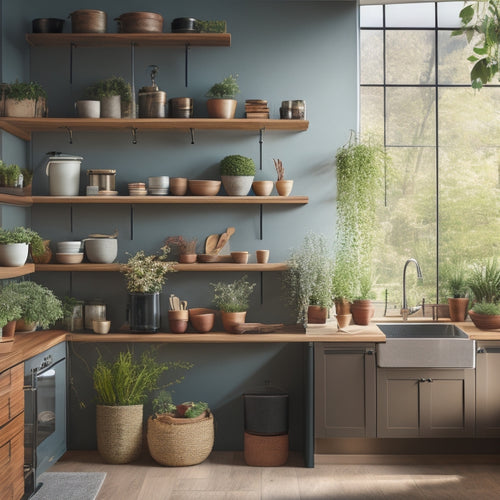
7 Best Strategies to Boost Kitchen Productivity
Share
You can boost kitchen productivity by up to 25% by implementing seven strategic changes. Start by streamlining your kitchen layout, positioning essential stations to maximize efficiency and reduce fatigue. Next, set up ergonomic workstations, optimizing equipment placement and implementing productivity hacks. Designate task-based zones, grouping similar tasks together to enhance time management and task completion. Assign roles and responsibilities, promoting accountability and minimizing errors. Maximize storage and accessibility, labeling each storage unit for easy access. Optimize cleaning and sanitation schedules, leveraging innovative technologies and tools to reduce waste and increase efficiency. By making these changes, you'll be on your way to transforming your kitchen into a high-performing, efficient machine - and there's even more to discover.
Key Takeaways
• Strategically position essential stations to maximize efficiency and reduce fatigue, optimizing workflow with the 'work triangle' concept.
• Designate specific zones for different tasks, grouping similar tasks together to enhance time management and task completion.
• Implement effective cleaning schedules and provide thorough training on sanitization techniques to prevent cross-contamination and foodborne illnesses.
• Invest in innovative technologies and tools, such as digital inventory management systems, to optimize food preparation and reduce waste.
• Delegate specific responsibilities to team members, streamlining the cooking process and promoting accountability and minimizing errors.
Streamline Your Kitchen Layout
Rethink your kitchen's workflow by strategically positioning essential stations, such as food prep, cooking, and cleanup, to minimize walking distances and maximize efficiency. By doing so, you'll create an ergonomic design that reduces fatigue and boosts productivity.
A well-planned layout will also improve workflow efficiency, allowing you to serve others more quickly and effectively.
To optimize space utilization, consider the 'work triangle' concept, where your most frequently used stations form the points of a triangle. This layout reduces traffic flow congestion and allows you to move seamlessly between tasks.
Additionally, designate specific areas for specific tasks, such as a prep zone for chopping and a cooking zone for stovetop or oven use. This organization will help you stay focused and avoid unnecessary steps.
Implement Efficient Workstations
By setting up efficient workstations, you'll be able to complete tasks quickly and effectively, freeing up time and energy to focus on other aspects of meal preparation. An ergonomic design is key to achieving this. Consider the height and placement of countertops, sinks, and appliances to create a comfortable and accessible workspace. This will reduce fatigue and prevent injuries, allowing you to work more efficiently.
Optimize equipment placement to streamline your workflow efficiency. Store frequently used items in easy-to-reach locations, and group similar tasks together. For example, place your knife block near the cutting board, and keep your spices close to the cooking station. This will save you time and effort, allowing you to focus on cooking rather than searching for ingredients.
Implementing productivity hacks can also boost your efficiency. Consider using a utensil organizer or a pot lid holder to keep your workspace clutter-free.
Prioritize Task-Based Zones
You can further enhance your kitchen's productivity by designating specific zones for different tasks, allowing you to stay focused on the job at hand and avoid unnecessary movement.
This task organization strategy helps you manage your time more efficiently, as you'll be grouping similar tasks together and completing them in one area.
For instance, you can create a prep zone for chopping, slicing, and dicing ingredients, a cooking zone for sautéing and roasting, and a plating zone for assembling and garnishing dishes.
Assign Roles and Responsibilities
To optimize kitchen workflow, identify the tasks that require collaboration and delegate specific responsibilities to each team member, ensuring that everyone knows their role in preparing a seamless meal service. This task delegation not only streamlines the cooking process but also promotes accountability among team members.
When each person is clear about their tasks, they can focus on their work, reducing confusion and minimizing errors.
Implementing role rotation and cross-training can also enhance kitchen productivity. By rotating roles, you'll identify areas where team members need additional training or support. Cross-training, on the other hand, enables team members to develop new skills, making them more versatile and efficient.
When you have a well-rounded team, you can adjust to last-minute changes or staff absences without compromising your service.
Maximize Storage and Accessibility
Efficiently organized storage systems and strategically placed equipment empower you to quickly access the tools and ingredients you need, saving time and reducing frustration in the kitchen. By implementing organization tips and space-saving solutions, you can maximize your kitchen's storage capacity.
Consider installing shelves, hooks, and baskets to keep frequently used items within easy reach. Label each storage unit to make sure you can find what you need at a glance.
Incorporate accessible design principles to optimize storage and reduce clutter. Store heavy or bulky items at the bottom of shelves or in easy-to-reach locations to avoid straining or stretching. Use storage optimization techniques, such as the 'first in, first out' rule, to make certain older ingredients are used before they expire.
Optimize Cleaning and Sanitation
By maintaining a clean and sanitized kitchen, you'll prevent cross-contamination and foodborne illnesses, guaranteeing a safe environment for food preparation and presentation. To achieve this, implement effective scheduling for daily, weekly, and monthly cleaning tasks. Assign specific duties to staff members and provide thorough training on sanitization techniques, such as proper handwashing, surface cleaning, and equipment sanitizing.
Regularly inspect and maintain equipment to prevent the buildup of bacteria and germs. Establish a routine for deep cleaning high-touch areas, like countertops, sinks, and refrigerators. Ensure staff understand the importance of cleaning as they go, wiping down surfaces, and sweeping/mopping floors to prevent crumbs and spills from accumulating.
Incorporate regular equipment maintenance into your schedule, including descaling, degreasing, and replacing worn-out parts. This proactive approach will minimize downtime, reduce repair costs, and maintain a clean, efficient kitchen.
Leverage Technology and Tools
You can greatly streamline kitchen operations and boost productivity by investing in innovative technologies and tools that simplify tasks, reduce labor, and enhance accuracy.
Automation integration, for instance, can help you optimize food preparation, reduce waste, and minimize labor costs.
Digital inventory management systems can also help you track stock levels, monitor expiration dates, and automate ordering, ensuring you always have the ingredients you need on hand.
Smart appliances, such as slow cookers and instant pots, can also significantly reduce cooking time and effort.
Productivity apps, like kitchen management software, can help you organize recipes, create menus, and assign tasks to team members.
These tools can also provide valuable insights into kitchen performance, helping you identify areas for improvement and make data-driven decisions.
Frequently Asked Questions
How Do I Handle Kitchen Tasks During Meal Prep With a Small Kitchen?
When tackling meal prep in your small kitchen, you'll maximize efficiency by implementing space-saving solutions, time-saving techniques, and clever organization tips, allowing you to multitask with ease and serve others with minimal stress.
Can I Customize Kitchen Productivity for My Cooking Style and Preferences?
You tailor your kitchen workflow to suit your cooking style, just as you season dishes to taste, by incorporating personalized customization and efficiency tips that streamline tasks, saving time and energy for what matters most - serving others.
What if I Have Limited Budget for Kitchen Renovations and Upgrades?
"If you're on a tight budget, don't worry! You can still upgrade your kitchen with budget-friendly solutions, like DIY projects, creative space-saving ideas, and secondhand finds that'll help you cook efficiently without breaking the bank."
How Do I Maintain Kitchen Productivity With a Large Family or Shared Space?
'When chaos reigns in your bustling kitchen, you're the maestro, orchestrating harmony among family members. Prioritize time management, organization, and clear communication to guarantee seamless teamwork, delegating tasks to each player to keep the kitchen symphony in perfect harmony.'
Are There Specific Kitchen Productivity Strategies for Specific Diets or Meal Plans?
When catering to specific diets, you'll find that vegan meal prep involves batch cooking legumes, Keto meal planning requires tracking macros, gluten-free cooking demands separate prep zones, and Paleo diet strategies focus on whole food prep.
Related Posts
-

Space-Saving Tiered Racks for Kitchen Storage
Space-saving tiered racks are your best solution for maximizing kitchen storage. They employ vertical space, allowing...
-

Easy-To-Install Kitchen Wall-Mounted Racks
Installing easy-to-use kitchen wall-mounted racks is a smart way to maximize your space. These racks help keep your c...
-

Corner Cabinet Storage for Dinnerware Sets
Corner cabinet storage for dinnerware sets can change your kitchen into an organized, stylish space. By utilizing ver...


